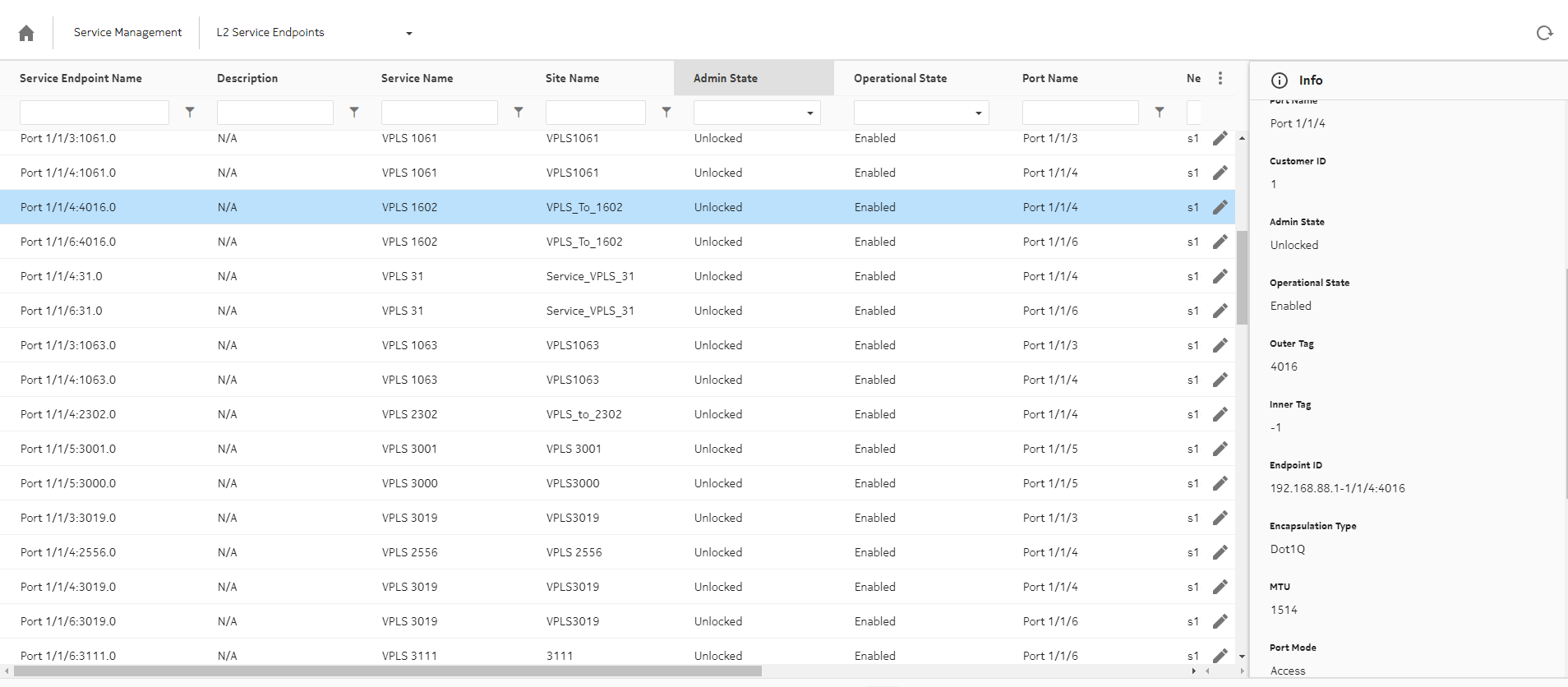How do I manage L2 backhaul services?
Service discovery
SRT discovers L2 backhaul services across BTS, microwave, and UBT nodes that are configured with the same VLAN. NSP displays services in Service Management. Navigating to the Service View, you can view service sites and service endpoints of the selected service in Details, Components, including Admin and Operational State.
The L2 backhaul service list is updated for BTS configuration changes (for example, creation/deletion of VLAN) and when BTS nodes are managed/unmanaged by NSP.
In this release, some configuration is required to view L2 services using Service Management. See Setup service management configuration for L2 services for more information.
See the NSP Service Management Guide for more information about managing services with Service Management.
Figure 3-9: Component view of L2 service displaying endpoints with Admin and Operational State
How BTS L2 services are created in NSP
The BTS requires the following for L2 backhaul service discovery:
-
L2SWI.l2SwitchingEnabled set to “true” and L2SWI.vlanAwarenessEnabled set to “true”
AND
-
the vlanId of the service configured on two ports of the BTS (in two BRGPRT.l2VlanIdList)
BTS L2 backhaul service name at service discovery is set to the value L2SVC_VLAN_XX, with XX equal to the vlanId. It is possible to modify the name of the BTS L2 backhaul service using Service Management.
Only singleton BRGPRT.l2VlanIdList (range with size 1, lowValue equals highValue in BTS) are taken into account for BTS L2 services creation.
Admin and Operational States
The Admin States of L2 services are not managed directly at the service level, only at the endpoint level. At the service level, the Admin State always displays as “Unlocked”. At the endpoint level, the Admin State is reflected by the value of the ETHLK administrationState.
The Operational State is managed at the service level by aggregating the operational state of all endpoints in the service. The Operational State of the service displays as “Disabled” if at least one port is operationally disabled/down.
L2 backhaul BTS service stitching
Service stitching can be performed in two ways:
-
automatically, as described in Enable automatic service stitching
-
manually, as described in Modifications of T-BTS L2 backhaul services do not appear in Service Management
Manual service stitching cannot be performed when automatic service stitching is enabled.
Managing BTS L2 services using Service Management
You can use the “Tbts Template” service intent in Service Management to create T-BTS L2 services. The following information must be specified when creating the service:
The Site Details specifies T-BTS nodes that are part of the service, with the endpoints for each T-BTS configured with the vlanId (at least two endpoints are required). All endpoints must be provided, including the final and intermediate endpoints along the path.
You can also use Service Management to perform updates (add/remove endpoint), audits, removal, and deletion for L2 services.
When the service is created, the corresponding BRGPRT.l2VlanIdList is created in the associated T-BTS nodes.
Note: Service creation and updates are only possible on T-BTS configured as “repeater” nodes (L2SWI.l2SwitchingEnabled and L2SWI.vlanAwarenessEnabled are set to true).
